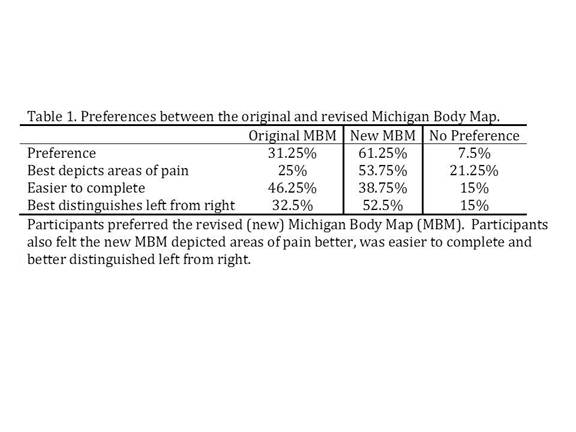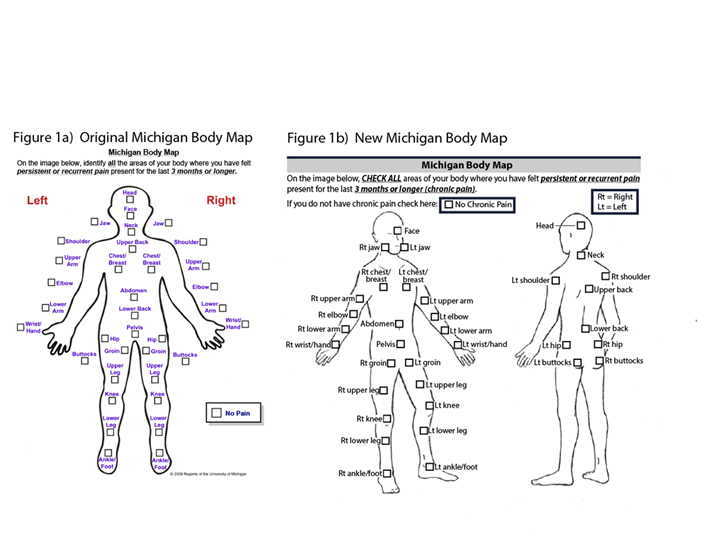Session Information
Session Type: ACR Poster Session B
Session Time: 9:00AM-11:00AM
Title: Validation of a
Revised Version of the Michigan Body Map
Background/Purpose:
One of the hallmark features of fibromyalgia and other
centralized pain states is widespread body pain. We developed the original Michigan Body Map
(MBM) as a self-report measure to assess widespread body pain in clinical care
and in epidemiological studies (Fig 1a).
It is a one-sided body image with check boxes for 35 body areas and a
box for “No Pain.” Whereas patients
preferred the original MBM to the Widespread Pain Index used to describe the body
areas for the 2011 Survey Criteria for Fibromyalgia (FM), there were some
issues with distinguishing left from right side body areas and some preferred
the two-sided image from the Brief Pain Inventory. We developed a new body map
(Fig 1b) that consists of the same 35 body areas, but is a two-sided image depicting
front and back. The aim of the present study was to assess patients’
understanding of and accuracy when completing the new MBM, as well as to assess
preference when compared to the original MBM.
Methods:
80 patients from the University of Michigan’s Physical
Medicine and Rehabilitation Spine Center were included in this study. Written informed consent was obtained. Patients
completed both the original MBM and the new MBM. Order of completion was
counterbalanced across participants. Understanding, accuracy and preference
between the two body maps were assessed.
Results:
Participants completed the original body map (34.5 sec) more
quickly than the new map (44 sec) (p = 0.003). Compared to the original map, the new map was more
frequently preferred, better allowed participants to show pain, and was easier
to accurately show painful areas on left and right sides (Table 1). 12 (15%) participants incorrectly flipped
left and right sides on the original MBM compared to only 4 (5%) participants
on the new MBM (p = .046). Participants incorrectly endorsed an average of 2.5
body areas on the original body map compared to only 1.6 on the new map (p = 0.004).
No
differences were found in the calculation of the count of 19 body areas used in
the 2011 survey criteria for FM in the original map (4.78 ±3.01) compared to
the new map (4.79 ± 3.3) (p = 0.922).
Conclusion:
Overall, participants demonstrated good understanding of the
new MBM and generally preferred it to the original MBM. There were no significant differences in the FM
survey scores between the old and new body maps suggesting that data from the
two different versions can be combined when necessary.
To cite this abstract in AMA style:
Brummett C, Bakshi R, Leung D, Zollars J, Goesling J, Moser S, Williams DA, Hassett AL. Validation of a Revised Version of the Michigan Body Map [abstract]. Arthritis Rheumatol. 2015; 67 (suppl 10). https://acrabstracts.org/abstract/validation-of-a-revised-version-of-the-michigan-body-map/. Accessed .« Back to 2015 ACR/ARHP Annual Meeting
ACR Meeting Abstracts - https://acrabstracts.org/abstract/validation-of-a-revised-version-of-the-michigan-body-map/


